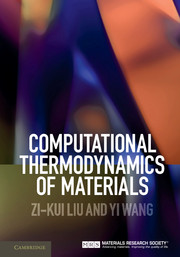Book contents
- Frontmatter
- Contents
- 1 Laws of thermodynamics
- 2 Gibbs energy function
- 3 Phase equilibria in heterogeneous systems
- 4 Experimental data for thermodynamic modeling
- 5 First-principles calculations and theory
- 6 CALPHAD modeling of thermodynamics
- 7 Applications to chemical reactions
- 8 Applications to electrochemical systems
- 9 Critical phenomena, thermal expansion, and Materials Genome®
- Appendix A: YPHON
- Appendix B: SQS templates
- References
- Index
4 - Experimental data for thermodynamic modeling
Published online by Cambridge University Press: 05 July 2016
- Frontmatter
- Contents
- 1 Laws of thermodynamics
- 2 Gibbs energy function
- 3 Phase equilibria in heterogeneous systems
- 4 Experimental data for thermodynamic modeling
- 5 First-principles calculations and theory
- 6 CALPHAD modeling of thermodynamics
- 7 Applications to chemical reactions
- 8 Applications to electrochemical systems
- 9 Critical phenomena, thermal expansion, and Materials Genome®
- Appendix A: YPHON
- Appendix B: SQS templates
- References
- Index
Summary
The most widely used thermodynamic modeling technique is the CALPHAD (CALculation of PHAse Diagram) method to be discussed in detail in Chapter 6. The input data in the evaluations of thermodynamic model parameters came primarily from experiments and estimations until first-principles calculations based on the density functional theory [8] became a user tool in the later 1990s. Experimental data include both thermodynamic and phase equilibrium data; the first-principles calculations, which provide thermodynamic data for individual phases, are discussed more extensively in Chapter 5.
Three fairly recently published books summarize the methods commonly used for experimental measurements of the thermodynamic properties of single [9] and multiple phases [10] and phase diagrams [11]. The methods are briefly discussed here, and readers are referred to these books for details. The main techniques for crystal structure analysis include X-ray diffraction, electron backscatter diffraction (EBSD), electron diffraction in transmission electron microscopy, neutron scattering, and synchrotron scattering, which are not discussed in this book.
Phase equilibrium data
Equilibrated materials
The most common method to determine phase equilibria is to use equilibrated materials. This method typically involves material preparation through high temperature melting or powder metallurgy, homogenization heat treatment, isothermal or cooling/heating procedures, and identification of crystal structures and phase compositions. It is important to avoid macro-inhomogeneity as it can be difficult to remove the inhomogeneity in subsequent treatments. It is also important to use starting materials of the highest purity and to minimize the loss and contamination of materials during the entire experiment using a protective atmosphere of inert gas or vacuum. Typical melting techniques include high temperature furnaces with crucibles, arc melting, and induction melting. Attention needs to be paid to possible reactions between materials and crucibles/containers, which can be avoided by levitating the materials by electromagnetic fields or other means. In addition to using pure elements as raw materials, master alloys with well-controlled compositions are often utilized because the compositions and melting properties of master alloys are usually much closer to those of the final materials than the pure elements. For materials with very high melting temperature or volatile components, the powder metallurgy method can be used where compacts are made, capsulated, and sintered.
Homogenization during subsequent heat treatment is achieved through diffusion, in which time and temperature are two important parameters.
Information
- Type
- Chapter
- Information
- Computational Thermodynamics of Materials , pp. 94 - 103Publisher: Cambridge University PressPrint publication year: 2016
